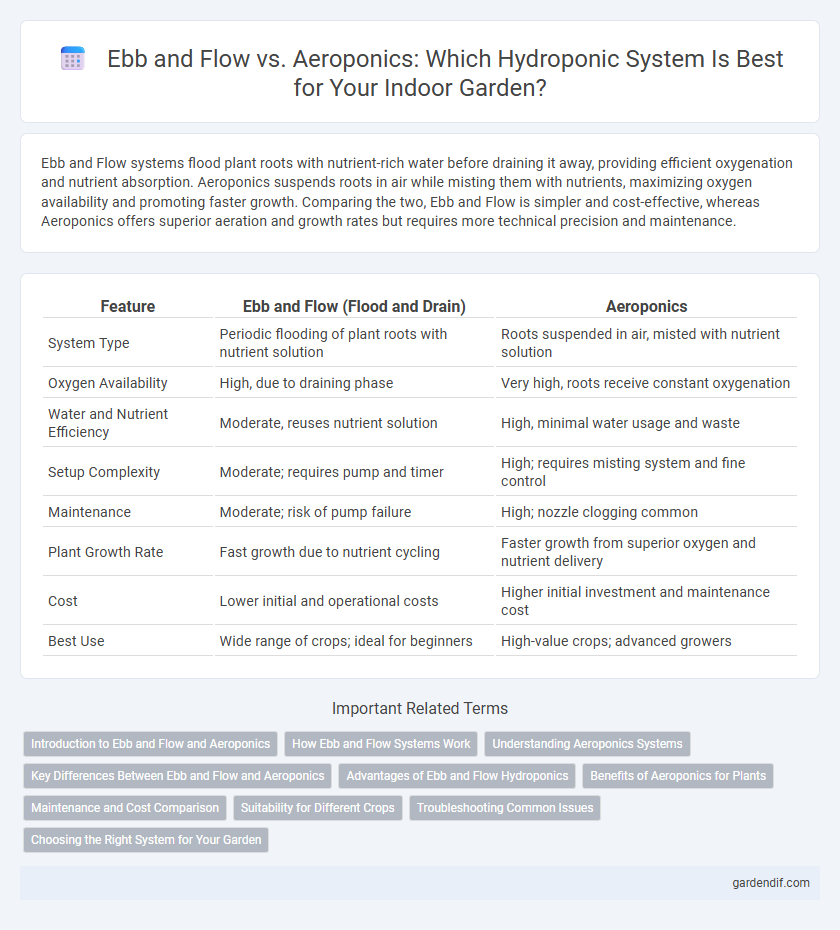
Ebb and Flow vs Aeroponics Illustration
Ebb and Flow systems flood plant roots with nutrient-rich water before draining it away, providing efficient oxygenation and nutrient absorption. Aeroponics suspends roots in air while misting them with nutrients, maximizing oxygen availability and promoting faster growth. Comparing the two, Ebb and Flow is simpler and cost-effective, whereas Aeroponics offers superior aeration and growth rates but requires more technical precision and maintenance.
Table of Comparison
| Feature | Ebb and Flow (Flood and Drain) | Aeroponics |
|---|---|---|
| System Type | Periodic flooding of plant roots with nutrient solution | Roots suspended in air, misted with nutrient solution |
| Oxygen Availability | High, due to draining phase | Very high, roots receive constant oxygenation |
| Water and Nutrient Efficiency | Moderate, reuses nutrient solution | High, minimal water usage and waste |
| Setup Complexity | Moderate; requires pump and timer | High; requires misting system and fine control |
| Maintenance | Moderate; risk of pump failure | High; nozzle clogging common |
| Plant Growth Rate | Fast growth due to nutrient cycling | Faster growth from superior oxygen and nutrient delivery |
| Cost | Lower initial and operational costs | Higher initial investment and maintenance cost |
| Best Use | Wide range of crops; ideal for beginners | High-value crops; advanced growers |
Introduction to Ebb and Flow and Aeroponics
Ebb and Flow hydroponic systems operate by periodically flooding the plant roots with nutrient-rich water, then draining to allow oxygen absorption, promoting robust growth through cyclical hydration. Aeroponics suspends plant roots in the air, misting them continuously with a nutrient solution, which maximizes oxygen exposure and nutrient uptake efficiency for accelerated plant development. Both methods offer controlled environments for soil-less cultivation, but Ebb and Flow emphasizes intermittent root immersion while Aeroponics relies on aerosolized nutrients.
How Ebb and Flow Systems Work
Ebb and Flow systems operate by periodically flooding the grow tray with nutrient-rich water, allowing plant roots to absorb essential nutrients and oxygen before draining the solution back into a reservoir. This cycle of flooding and draining creates an optimal balance between moisture and aeration, promoting vigorous root growth and nutrient uptake. The automated timing of water flow enhances resource efficiency and minimizes the risk of root diseases compared to aeroponics, which continuously mists roots in air.
Understanding Aeroponics Systems
Aeroponics systems deliver nutrient-rich water mist directly to plant roots suspended in air, promoting enhanced oxygenation and faster growth compared to ebb and flow systems that periodically flood the root zone. This soil-less method maximizes nutrient uptake efficiency and reduces water usage by recycling mist in a closed environment. Understanding aeroponics involves recognizing its precision in root stimulation, aeration, and minimal disease risk, which can lead to higher yields in controlled environments.
Key Differences Between Ebb and Flow and Aeroponics
Ebb and Flow hydroponic systems utilize periodic flooding and draining of nutrient solutions to plant roots, promoting oxygenation and nutrient absorption through substrate media, while Aeroponics suspends roots in air and delivers nutrients via fine mist for maximum oxygen exposure and efficient nutrient uptake. Ebb and Flow requires a reservoir, pump, and grow tray to cycle nutrients, contrasting with Aeroponics' need for misting nozzles and precise environmental control to prevent root drying. Ebb and Flow systems excel in simplicity and cost-effectiveness, whereas Aeroponics offers faster growth rates and water efficiency but demands higher maintenance and technical expertise.
Advantages of Ebb and Flow Hydroponics
Ebb and Flow hydroponics offers superior nutrient delivery through periodic flooding and draining, promoting oxygenation and root health, which enhances plant growth efficiency. This system is cost-effective and simple to set up compared to aeroponics, requiring less specialized equipment and maintenance. Its adaptability to various plant types and scalability makes Ebb and Flow a versatile solution for both small-scale and commercial hydroponic farming.
Benefits of Aeroponics for Plants
Aeroponics promotes superior oxygenation to plant roots, enhancing nutrient absorption and accelerating growth rates compared to Ebb and Flow systems. By suspending roots in an oxygen-rich mist, aeroponics improves water efficiency and reduces the risk of root diseases. This method supports higher yields and healthier plants through optimal air circulation and nutrient delivery.
Maintenance and Cost Comparison
Ebb and Flow systems require regular cleaning and monitoring of pumps and flood cycles, making maintenance moderate and accessible for beginners, with initial setup costs ranging from $150 to $500 depending on system size. Aeroponics demands more precise maintenance, including frequent nozzle cleaning and high humidity control to prevent system clogging and plant diseases, leading to higher operational complexity and costs that can exceed $1,000 for advanced setups. Cost-effectiveness favors Ebb and Flow for hobbyists and small-scale growers, while Aeroponics offers higher yield potential but requires greater investment in maintenance and equipment.
Suitability for Different Crops
Ebb and Flow systems are highly suitable for a wide range of crops, including leafy greens, herbs, and fruiting plants, due to their efficient nutrient delivery and relatively simple setup. Aeroponics excels with delicate and high-value crops such as orchids, lettuce, and strawberries, offering superior oxygenation and faster growth rates. Crop selection depends on factors like root sensitivity, growth cycle, and space availability, with Ebb and Flow providing robust versatility and Aeroponics emphasizing precision and maximal yield per square foot.
Troubleshooting Common Issues
Ebb and Flow systems often face challenges like pump failure, nutrient solution imbalances, and waterlogging, which require monitoring pump timers, checking water pH/EC levels, and ensuring proper drainage. Aeroponics troubleshooting focuses on preventing nozzle clogging, maintaining consistent misting cycles, and avoiding root desiccation by regularly cleaning nozzles and monitoring humidity inside the root chamber. Both methods demand vigilant system maintenance and real-time environmental control to optimize plant growth and prevent common failures.
Choosing the Right System for Your Garden
Ebb and Flow systems excel in simplicity and cost-effectiveness, making them ideal for beginners and small-scale gardens. Aeroponics offers superior oxygenation and faster plant growth rates, suited for high-tech, space-efficient setups. Selecting the right system depends on factors like budget, available space, maintenance capacity, and crop type preferences.
Ebb and Flow vs Aeroponics Infographic

 gardendif.com
gardendif.com